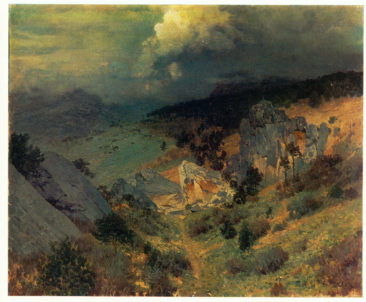

Isaak Ilich Levitan was born into an intelligent family. The father of the artist was a teacher of foreign languages, he gave lessons in private houses, and also worked as an interpreter, cashier and controller at railway stations. In the late 1860’s the family moved to Moscow, and in the autumn of 1873 the thirteen-year-old Isaac Levitan entered the Moscow School of Painting, Sculpture and Architecture. The teachers of the future artist were such famous painters as Vasily Perov, Alexei Savrasov, Vasily Polenov.
At the apprenticeship exhibition in 1880, Levitan presented the painting “Autumn Day: Sokolniki” (1879). This canvas, imbued with sadness and lyricism, filled with a sense of autumn withering and human loneliness, attracted the attention of viewers and received, perhaps, the highest possible at the time assessments – the picture was acquired by Pavel Tretyakov, the founder of the famous State Tretyakov Gallery, a sensitive lover of landscape painting, above all put not “beauty of nature”, but the soul, the unity of poetry and truth.
The works of Levitan are filled with a special worldview peculiar to him, reverence for life. It is known that the artist also treated plants, flowers and trees as creatures, our lesser brothers, able to feel, rejoice, reach for the sun in the days of spring, and grieve, dropping leaves before the onset of cold weather.
Until the mid-1880s, Levitan worked exclusively in Moscow and the Moscow region, but then the “geography” of his art expanded. In 1886, the artist made a trip to the Crimea, and in the spring of 1887 he set off on a journey across the Volga. Isaak Levitan was fascinated by the beauty of the small quiet town of Plyos and spent three fruitful summer seasons there.
In 1892, eviction from Moscow of people of Jewish nationality began, and Levitan was ordered as an “unbaptized Jew” to leave the city in twenty-four hours. Despite the protests of the artistic community, the painter had to live for some time in Tver, then in the Vladimir province. At this time, the artist wrote his famous trilogy. These are the pictures “In the whirlpool”, “Over eternal rest”, “Vladimirka”. The picture “Vladimirka” was written under the impression of a meeting in the summer of 1892 with this notorious tract, whereby convicts were sent to Siberia. This work, perhaps, most clearly reflected the acuteness of the social responsiveness of the painter, and his unhappy knowledge of the lawlessness and grief of the people.
The creative path of Isaac Levitan was not long, only about twenty years, but the artist’s legacy is enormous. It can be said without exaggeration that after it the Russian landscape became different. Levitan died in 1900, becoming the last brightest figure in the golden age of Russian culture.